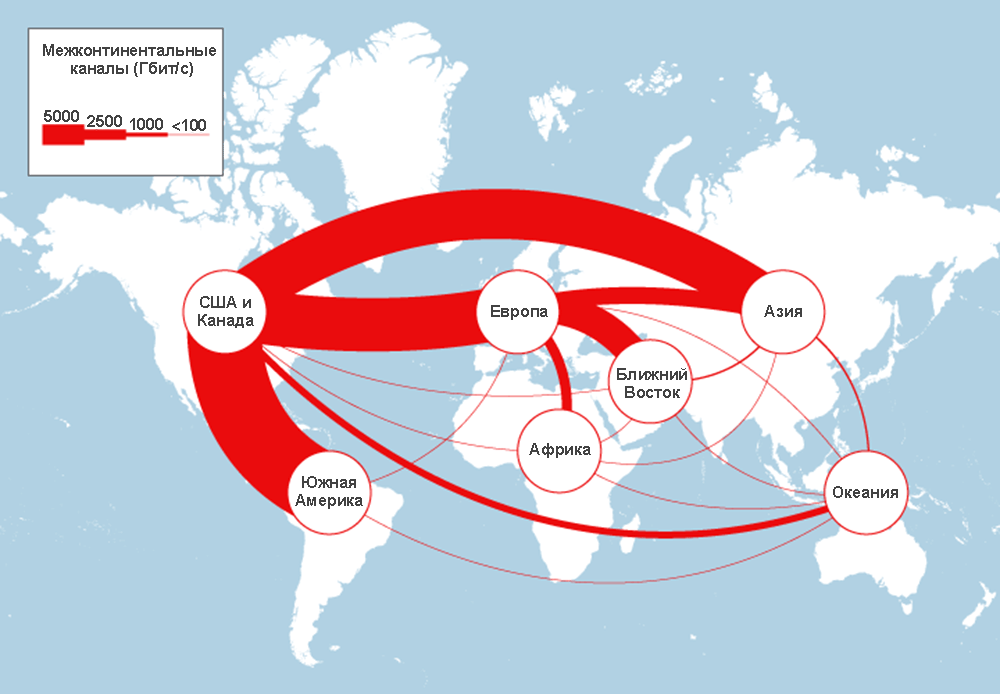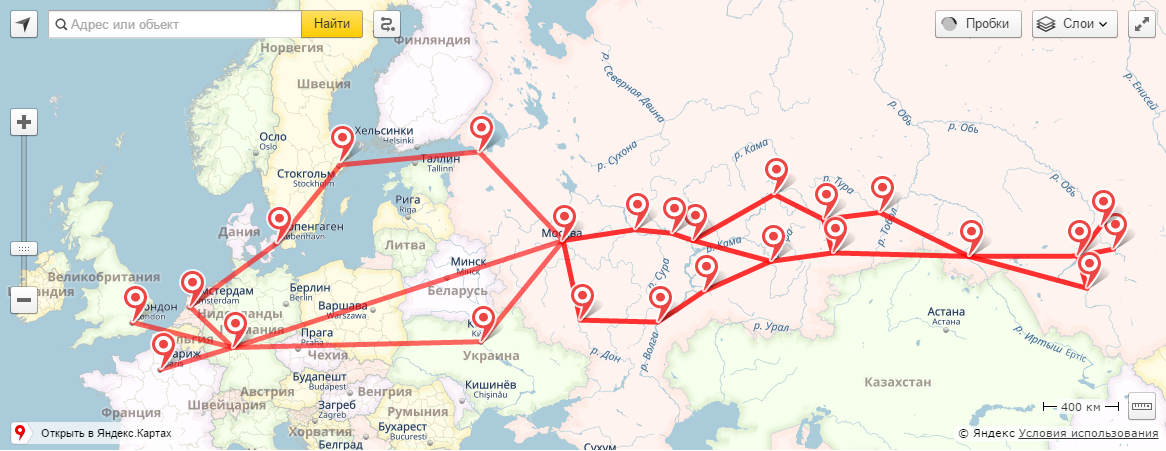World Internet circulatory system

TeleGeography Infographics
Google launches a swarm of balloons in the stratosphere , and Facebook - an army of solar-powered drones . But these are only small geek toys that dream of covering the entire planet with a bond. Their ambitious services will be a tiny addition to the powerful basic infrastructure of the World Wide Web - an extensive network of land and underwater trunk channels. That is where the real circulatory system of modern civilization. This is where her pulse beats.
Largest hubs
At the physical level, the Internet represents a network of hubs (traffic exchange points) connected by backbone channels. Not only traffic is concentrated at the traffic exchange points, but also the network infrastructure (data centers, hosting, etc.). The largest exchange points are located in Frankfurt, Amsterdam, London and Paris. In a sense, these cities can be considered the capitals of the world Internet. At least, precisely the largest network nodes, along with New York, which is also among the top five major hubs.
')
The list of the largest traffic exchange points in the world is dominated by DE-CIX (peak bandwidth 5178 Gbit / s), AMS-IX (4270 Gbit / s). Russian MSK-IX is in 5th place (2135 Gbit / s).
The aggregate throughput of all international communication channels is 180 Tbit / s (in 2015).
In terms of the number of international channels, Europe has long been the absolute leader, surpassing any other continent. But now about the same in North America (read - in the United States), then Asia, South America and Africa. A decade ago, more than half of the international communication channels on the planet landed in Europe. Now less than half, but Europe still remains a key node in the global network.

The European hub differs from the rest of the continents in another detail: about 70% of international traffic moves between cities within the continent. For comparison, South America and Africa have the opposite picture: 80% of the channels go to other continents. By the way, 60% of the external channels of South America are connected to one foreign city: Miami. So if a blackout happens in Miami, South America will partially fall out of the Internet.
Almost all channels of communication between the continents are laid along the bottom of the ocean.
Underwater backbones
The underwater internet is probably the most interesting (and secret) part of the global network infrastructure. Secret, because just like that you will not find the exact map of laying a specific cable. Russia and some other countries keep this information secret, and for good reason (see the articles on Habré “ Submarine USS Jimmy Carter, its special tasks ”, “The hidden connection to optical fiber: methods and precautions ”). No cable is protected from extraneous connection, no matter where it is located.

2016 submarine cable map
According to the data for 2014, 285 communication cables were laid across the ocean floor, 22 of them were not used, these are the so-called “dark cables” (“dark optical trap”) - there are a lot of such unused cables on land. For example, the same Google company buys dark fiber for communication between data centers. When they send a signal over dark fiber, they say that it is “lit” like a lamp.
The estimated lifetime of the fiber is 25 years, which is a purely theoretical value. It is assumed that during such time commercial operation of the channel will make sense. Accordingly, on the basis of such a term, economists expect a return on investment. For example, it’s more profitable for Google to lay its own cable across the Pacific Ocean than to rent someone else for 25 years.

As traffic grows on the Internet (it grows by about 37% per year ), operators upgrade the fiber - “compact” it to transmit data simultaneously in several spectral channels due to spectral multiplexing . In addition, more efficient phase modulation techniques are being introduced and more modern terminal equipment is being installed. Accordingly, the capacity of the trunk channel increases in proportion to the frequency band over which data is transmitted.
A good illustration is the transatlantic information highway. In 2003-2014, not a single (!) New cable was laid here, but the throughput capacity of the existing channels increased 2.4 times exclusively due to the sealing of the channels and the upgrade of the equipment. And these cables still have a large margin for the future.

Increased throughput of transatlantic communication channels in 2003-2014
Laying a cable and putting it into operation is a long procedure that lasts several years and is quite expensive, so several corporations usually jointly fund such projects, and then divide the fiber optic pairs in the cable between them. For example, on June 29, 2016, Google and its partners (China Mobile International, China Telecom Global, Global Transit, KDDI, Singtel) announced the launch of the world's largest submarine cable at 60 Tbps trans-ocean cable . A cable with a length of 9000 km connected Japan and the USA (here Japan plays the role of a hub between the USA and China).

FASTER
This particular cable consists of 6 fiber pairs. Each pair is capable of transmitting a signal in 100 wavelength ranges of 100 Gbit / s for each length (10 Tbit / s for each fiber-optic pair). This corresponds to a 60 Tbps maximum bandwidth for each cable - this is not the theoretical, but the actual maximum bandwidth demonstrated in the tests.
But at first, throughput will not even come close to this limit. At the first stage, only 2 to 10 channels will be involved, that is, 2-10% of the maximum cable capacity. Over the course of the 25-year lifespan, Google with partners will gradually increase its bandwidth as needed.
Google owns one or two of the six fiber pairs in the cable, accurate information is kept secret. Although the cost of laying the FASTER highway was $ 300 million, for an Internet company it is really cheaper than renting the same channels from others. In addition, as Google gets more control over the lines of communication that link its data centers.
By the way, Microsoft and Facebook, following the example of Google, are now also forming a consortium for laying their transatlantic cable MAREA.
Networks in Europe

If the main communication channels are compared with the circulatory system of modern civilization, then Europe is its heart.
The map of main canals in Europe changes slightly every year. Between the largest nodes of the network, sometimes new channels are laid with greater bandwidth and / or less delay (that is, along a more optimal route). In some cases, the channels may even “disappear”, that is, they are no longer used if the operator for some reason decides to redirect the link from one city to another. In the early 2000s, the transatlantic route New York-London was the largest international communication channel in the world, but in 2009 a thicker Amsterdam-London channel was built, and then this record was broken by a new “champion” - the Frankfurt-Paris highway.
Around this time, the final structure of network backbones in Europe was formed with the four largest traffic exchange points in the world.
- Frankfurt
- London
- Paris
- Amsterdam
According to world statistics , only about 25% of the most popular sites in each country are located at home (on average). The share of national hosting is noticeably higher in China, Iran, Turkey and Russia, for obvious reasons.

The physical location of the servers of the 100 most popular sites in some countries, April 2015. Source: TeleGeography
Connection with Russia
From the point of view of reliability, the server is optimally located near the largest traffic exchange point that connects Russia with the global Internet.
Russia in some sense was lucky. Next to the Russian segment of the Internet are the world's largest network hubs. The closest geographically and, by coincidence, the world's largest traffic exchange point is DE-CIX in Frankfurt. Three of the largest Russian operators of traffic exchange MSK-IX ( 2 Tbit / s ), Data-IX ( 2 Tbit / s ), W-IX ( 1 Tbit / s ), with an average load of 3.2 Gbit / s are connected here.
The map of the Rostelecom trunk networks and the map of the international trunk operator RETN show which channels the Russian segment connects to the world's largest exchange points. The new fast line of Rostelecom from Moscow to Frankfurt is also indicated.

Map of backbone networks of Rostelecom

RETN backbone network map
For traffic exchange, operators can enter into agreements with each other or choose more advanced peering such as W-IX . This system operates within one city at the second level, and the communication between the participants is carried out, as in any other peering, directly. At the same time, communication with all other traffic exchange points, in which the W-IX is a participant, is carried out through the route server.

W-IX
W-IX has its own international channels between the largest traffic exchange points.

W-IX
Experts note that in recent years there has been a certain tendency towards traffic localization, when servers are located within the national borders of the country where the main audience is located. The proliferation of CDN services and information security measures associated with the threat of confidential information leaks are in favor of localization. Now not only Russia, but also other countries are considering laws obliging to keep confidential information (including financial and medical ones) only within the country.
Fortunately, localization requirements affect only a limited number of websites, so Internet companies can still choose a hosting site based on their own needs. Placing servers next to global network hubs makes servers more accessible to a global audience and is much cheaper because all relevant network infrastructure, including data centers and hosting providers, is concentrated around hubs.

Source: https://habr.com/ru/post/305634/
All Articles